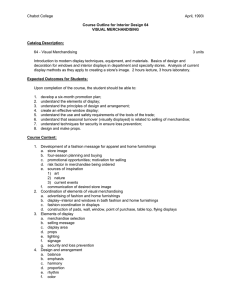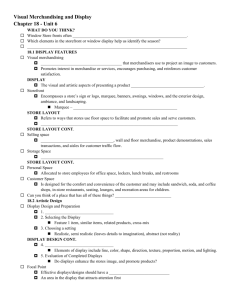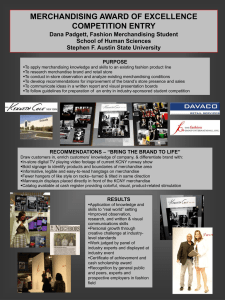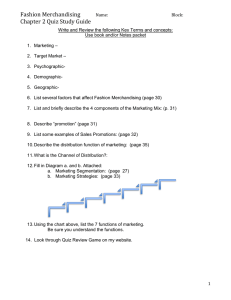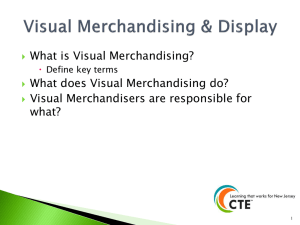Lesson Plan
advertisement
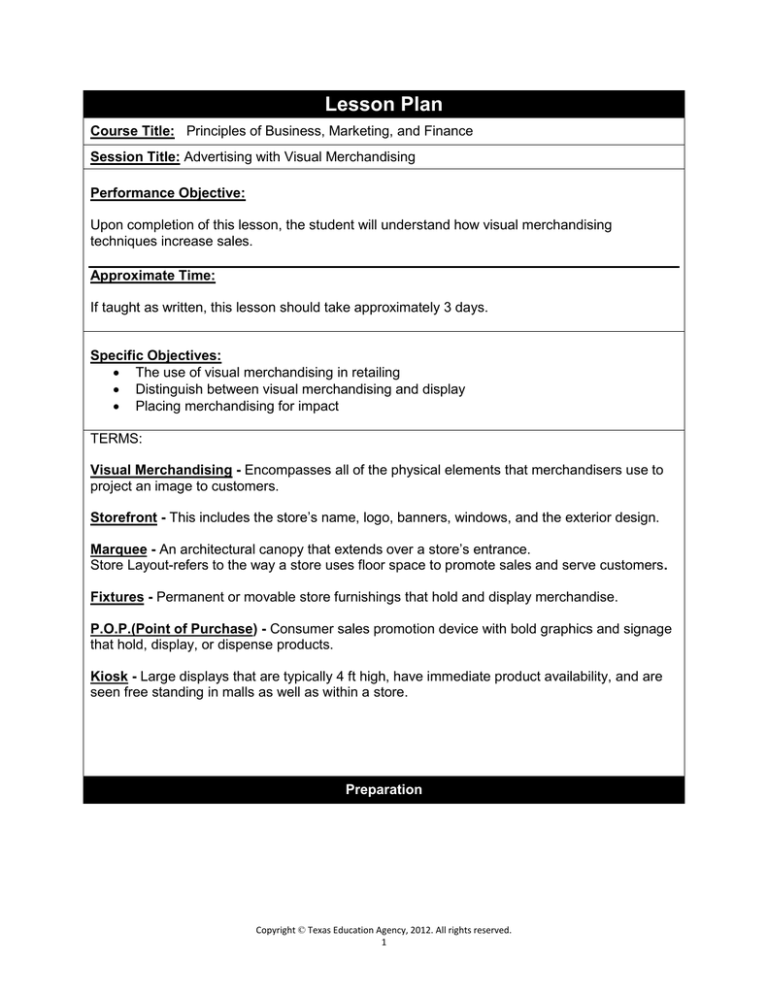
Lesson Plan Course Title: Principles of Business, Marketing, and Finance Session Title: Advertising with Visual Merchandising Performance Objective: Upon completion of this lesson, the student will understand how visual merchandising techniques increase sales. Approximate Time: If taught as written, this lesson should take approximately 3 days. Specific Objectives: The use of visual merchandising in retailing Distinguish between visual merchandising and display Placing merchandising for impact TERMS: Visual Merchandising - Encompasses all of the physical elements that merchandisers use to project an image to customers. Storefront - This includes the store’s name, logo, banners, windows, and the exterior design. Marquee - An architectural canopy that extends over a store’s entrance. Store Layout-refers to the way a store uses floor space to promote sales and serve customers. Fixtures - Permanent or movable store furnishings that hold and display merchandise. P.O.P.(Point of Purchase) - Consumer sales promotion device with bold graphics and signage that hold, display, or dispense products. Kiosk - Large displays that are typically 4 ft high, have immediate product availability, and are seen free standing in malls as well as within a store. Preparation Copyright © Texas Education Agency, 2012. All rights reserved. 1 TEKS Correlations: This lesson, as published, correlates to the following TEKS. Any changes/alterations to the activities may result in the elimination of any or all of the TEKS listed. 130.112 (c) (10) The student understand how to incease sales by employing visual merchandising techniques and using special events to increase sales. 130.112 (c)(10) (A) Explain the use of visual merchandising in retailing 130.112 (c) (10) (B) Distinguish between visual merchandising and display 130.112 (c)(10)(C) Place merchandise for impact Interdisciplinary Correlations: English: 110.33(b)(1)(A) – Reading/Vocabulary Development …determine the meaning of grade-level technical academic English words in multiple content areas (e.g., science, mathematics, social studies, the arts) derived from Latin, Greek or other linguistic roots and affixes. 110.33(b)(1)(B) – Reading/Vocabulary Development … analyze textual context (within a sentence and in larger sections of text) to draw conclusions about the nuance in word meanings. 110.33(b)(1)(C) – Reading/Vocabulary Development …infer word meaning through the identification and analysis of analogies and other word relationships. 110.33(b)(9)(C) – Reading/Comprehension of Informational Text/Expository Text …make and defend subtle inferences and complex conclusions about the ideas in text and their organizational patterns. 110.33(b)(11)(B) – Reading/Comprehension of Informational Text/Procedural Text …translate (from text to graphic or from graphic to text) complex, factual, quantitative, or technical information presented in maps, charts, illustrations, graphs, timelines, tables and diagrams. 110.33(b)(12)(A) – Reading/Media Literacy …evaluate how messages presented in media reflect social and cultural views in ways different from traditional texts. 110.33(b)(12)(B) – Reading/Media Literacy …evaluate the interactions of different techniques (e.g., layout, pictures, typeface in Copyright © Texas Education Agency, 2012. All rights reserved. 2 print media, images, text, sound in electronic journalism) used in multi-layered media. 110.33(b)(12)(C) – Reading/Media Literacy …evaluate the objectivity of coverage of the same event in various types of media. 110.33(b)(12)(D) – Reading/Media Literacy …evaluate changes in formality and tone across various media for different audiences and purposes. Occupational Correlation (O*Net – www.onetonline.org/) Job Title: Public Relations Specialists O*Net Number: 27-3031.00 Reported Job Titles: Account Executive, Public Affairs Specialist, Public Relations Specialist (PR Specialist). Tasks: Respond to requests for information from the media or designate an appropriate spokesperson or information source. Study the objectives, promotional policies, or needs of organizations to develop public relations strategies that will influence public opinion or promote ideas, products, or services. Plan or direct development or communication of informational programs to maintain favorable public or stockholder perceptions of an organization's accomplishments or agenda. Soft Skills: Speaking, Active listening, and Social Perceptiveness. Accommodations for Learning Differences: It is important that lessons accommodate the needs of every learner. These lessons may be modified to accommodate your students with learning differences by referring to the files found on the Special Populations page of this website. Introduction Teacher Preparation: Teacher will review the terms in the outline, PowerPoint, and handouts to become familiar with lesson. References: Textbooks: Advertising & Integrated Brand Promotion. O’Guinn-Allen-Semenik. Thompson South-Western. Advertising-Business 2000 Townsley South-Western. Marketing Essentials, Glencoe Instructional Aids: Projector/Presentation Textbooks and website Copyright © Texas Education Agency, 2012. All rights reserved. 3 Materials Needed: 1. Printer Paper 2. Assignment handouts Equipment Needed: 1. Computers for teacher/students with PowerPoint and Internet access. 2. Projector Learner Preparation: Tell students that our objective today will be talking about visual merchandising techniques to increase sales. Introduction Introduction: (Day 1) ASK: Students to name their favorite clothing store. What do they like about the store? What about your favorite grocery store? What about restaurant? Discuss answers in class. SAY: Stores that are successful usually have a good use of visual merchandising. These are the visual and artistic of the entire business environment. The goal of visual merchandising is to create a positive shopping experience that will compel customers to return. Merchandisers consider key elements to achieving this goal. Go back to discussing their original favorite stores. Do these stores have good visual merchandising like displays and lighting? What makes a store approachable? Discuss the importance of the visual merchandising in a store. Copyright © Texas Education Agency, 2012. All rights reserved. 4 ASK: Students why do they think sale merchandise is always at the back of the store? Why is new merchandise usually in the windows or front of the store? What type of merchandise makes a bigger impact? EXPLAIN: Sale merchandise is usually in the back so that customers must walk through the entire store to get to it. This way, they will be more tempted to purchase something else along the way. New merchandise makes a bigger impact in windows and in windows and gets the customer into the store. Stores also regularly move their merchandise around as the give the appearance of “new” products. This goes from everything to clothing, to food, to electronics. Outline Outline: Instructors can use the presentation, slides, handouts, and note pages in conjunction with the following outline. MI Outline I. II. A. B. C. D. E. F. G. III. A. B. C. D. IV. A. B. C. D. Introduction A. Question/discussion about favorite clothing store. B. Goals of visual merchandising C. Key elements of visual merchandising D. Placing merchandise for impact E. Sale merchandise vs. new merchandise Guided Practice-The Use of Visual Merchandising in RetailingPowerPoint Presentation Storefront Marquee Store Layout Fixtures P.O.P-Point of purchase Kiosk Store Layout Selling space Storage space Personnel space Customer space Store Interior Lighting Bright colors Interior signage Bold graphics Copyright © Texas Education Agency, 2012. All rights reserved. 5 Notes to Instructor (Day 1-2) Use Presentation as visual aid. After introduction,have students write down key terms on a piece of paper and then write down what they think the meanings are. On a three column chart, have student’s list three stores. Then have them list three store events or occasions that are featured in window displays and describe how the windows may look. Have them explain in their opinion what type of product placement would make the biggest impact? V. Interior Displays A. Closed displays B. Open displays C. Architectural displays D. Point of purchase displays E. Store decorations 6. Independent Practice A. Guess term meanings B. 3 Column Store Chart C. 5 Interior Display assignment 7. Formal Assessment A. Written paper on stores and visual merchandising Verbal Linguistic Logical Mathematical Visual Spatial Musical Rhythmic Bodily Kinesthetic Intrapersonal Have students take the 5 interior displays and list a store that would have that type of display and why. (Day 2-3)Review prior lesson. Have students research 3 completely different stores online and report as many visual merchandising findings that they can. These are to include : Displays, lighting, fixtures, merchandise, P.O.P, Storefront, etc. Have them explain the target audience for store and their reasoning behind it. Explain how each store makes an impact with their product placement . Have Presentation up for reference. This is to be a written paper. 1-2 pages. Paper will be graded with rubric. Interpersonal Application Copyright © Texas Education Agency, 2012. All rights reserved. 6 Naturalist Existentialist Guided Practice: (Day 1) Presentation and key terms (see intro above) Independent Practice: 1. Have students write down key terms on a piece of paper and then write down what they think the meanings are. 2. On a three column chart, have student’s list three stores. Then have them list three store events or occasions that are featured in window displays and describe how the windows may look. Describe in their opinion how the merchandise should be placed to make the biggest impact. 3. Have students look and consider the 5 interior display types on the presentation. Have students list a store that would have that type of display and their reasoning behind it. This can be done on a word processing document. Summary Review: Why is visual merchandising important at retail? What four key elements are considered visual merchandising success? What are the five types of interior displays? Evaluation Informal Assessment: Instructor will be observant with students during asignments and discussions. Instructor will move about the classroom settng, providing feedback and making sure that students are participating and on task. Formal Assessment: (Day 2-3) Have students research 3 completely different stores online. Report the different visual merchandising aspects of each store. These are to include : Displays, lighting, fixtures, merchandise, P.O.P, Storefront, etc. Have them explain the target Copyright © Texas Education Agency, 2012. All rights reserved. 7 audience for store and their reasoning behind it. Decribe product placement and impact. Have Presentation up for reference. This is to be a written paper. 1-2 pages. Paper will be graded with rubric. Extension Extension/Enrichment: If time allows, have students give 3 minute presentations of their paper. Copyright © Texas Education Agency, 2012. All rights reserved. 8 Formal Assessment : Rubric Student Name: _______________ _______________ _______________ ________ CATEGORY Organization Quality of Information Amount of Information Sources Diagrams & Illustrations 20 15 10 5 or less Information is very organized with well-constructed paragraphs and subheadings. Information clearly relates to the main topic. It includes several supporting details and/or examples. All topics are addressed and all questions answered with at least 2 sentences about each. All sources (information and graphics) are accurately documented in the desired format. Information is organized with well-constructed paragraphs. Information is organized, but paragraphs are not well-constructed. The information appears to be disorganized. 8) Information clearly relates to the main topic. It provides 12 supporting details and/or examples. Information clearly relates to the main topic. No details and/or examples are given. Information has little or nothing to do with the main topic. All topics are addressed and most questions answered with at least 2 sentences about each. All sources (information and graphics) are accurately documented, but a few are not in the desired format. Diagrams and illustrations are accurate and add to the reader's understanding of the topic. All topics are addressed, and most questions answered with 1 sentence about each. All sources (information and graphics) are accurately documented, but many are not in the desired format. Diagrams and illustrations are neat and accurate and sometimes add to the reader's understanding of the topic. One or more topics were not addressed. Diagrams and illustrations are neat, accurate and add to the reader's understanding of the topic. Copyright © Texas Education Agency, 2012. All rights reserved. 9 Some sources are not accurately documented. Diagrams and illustrations are not accurate OR do not add to the reader's understanding of the topic.
